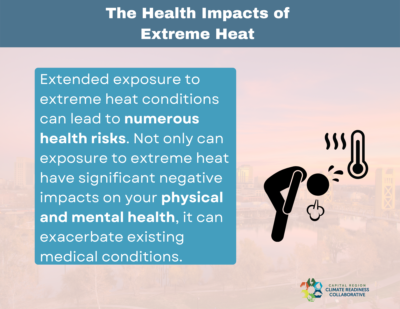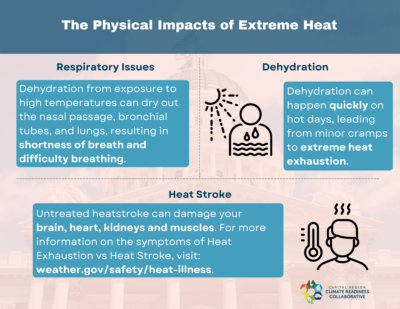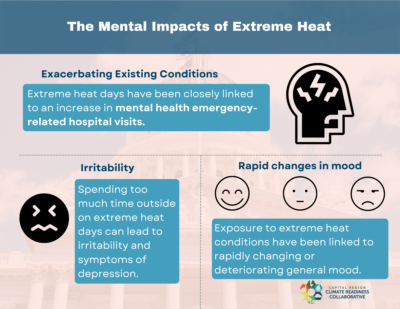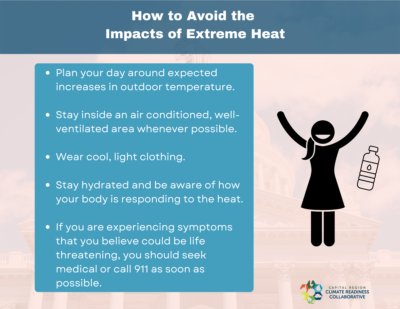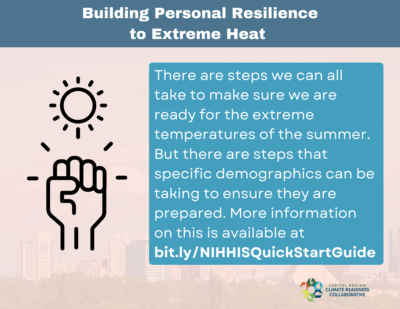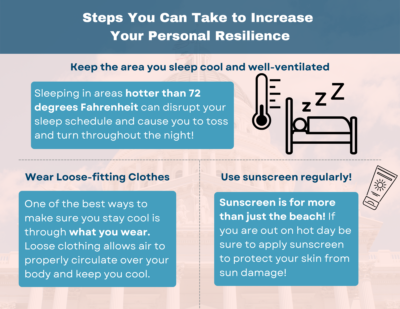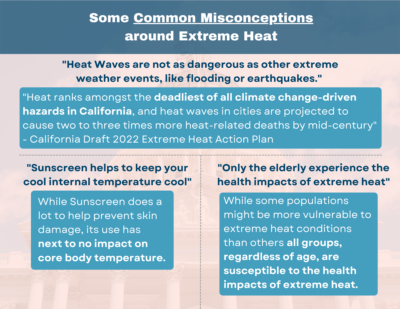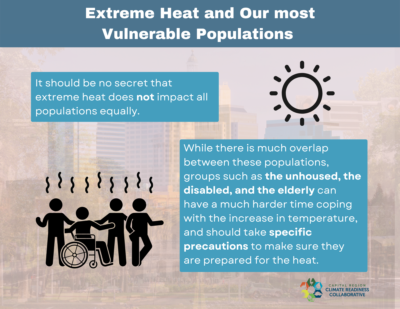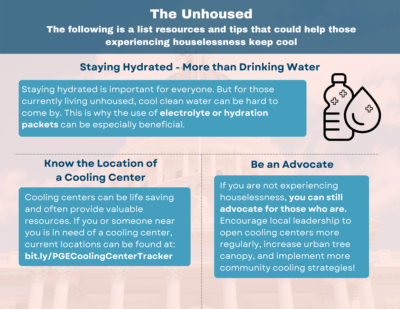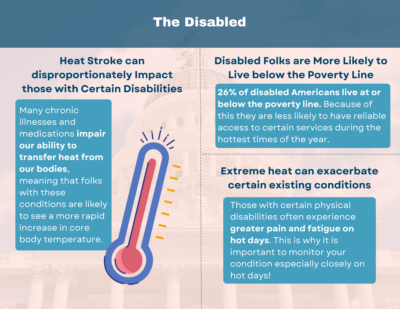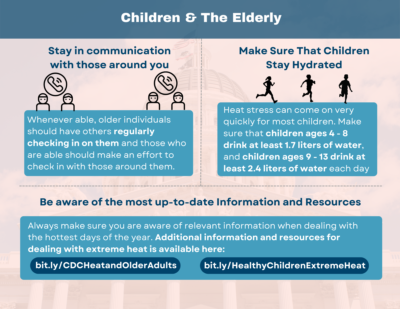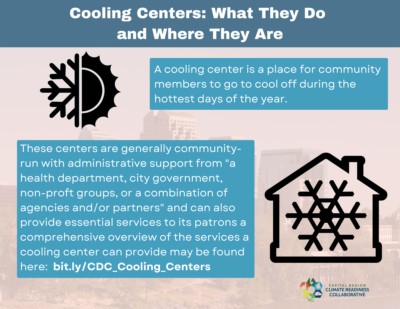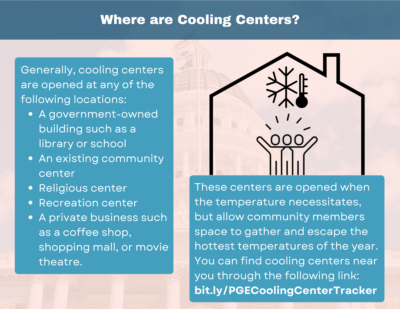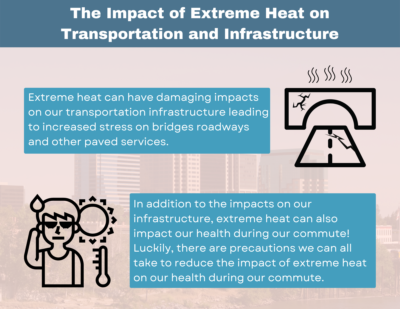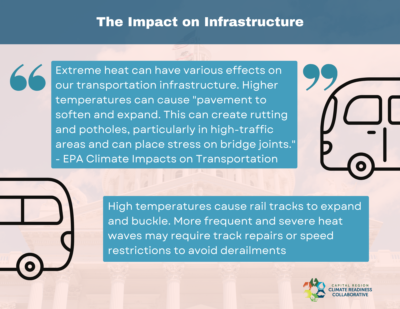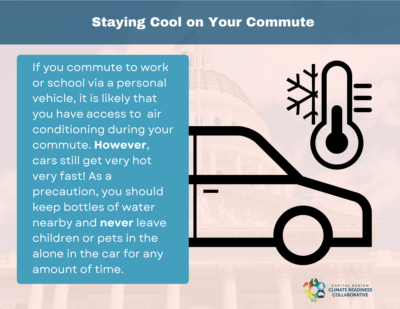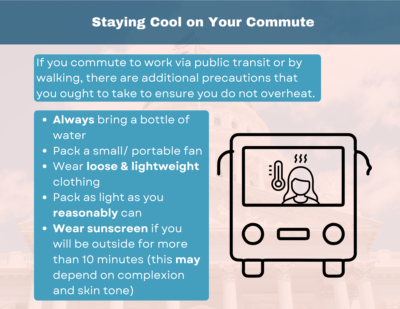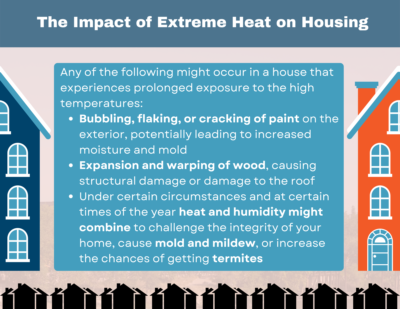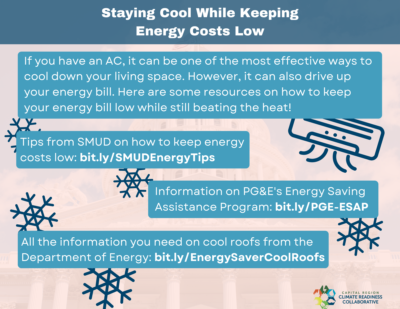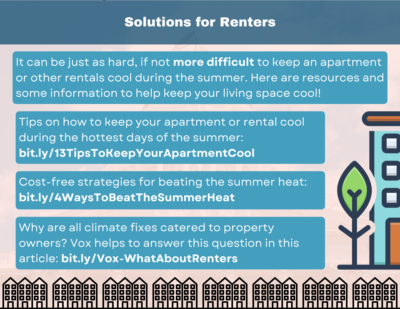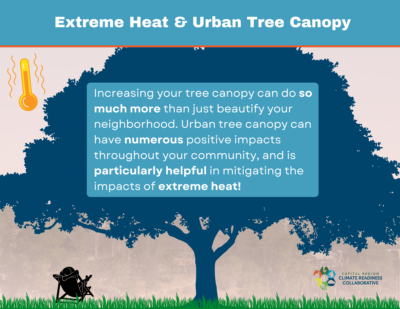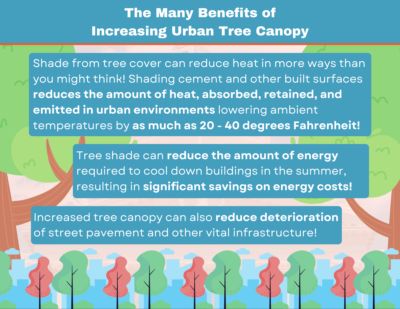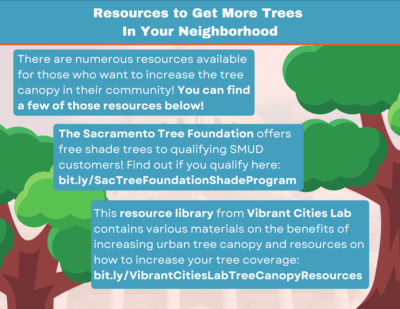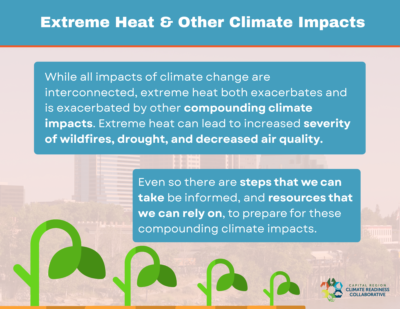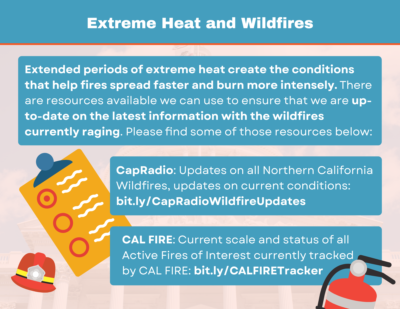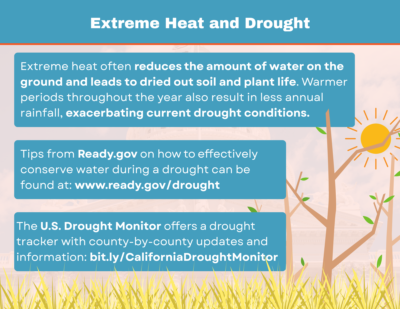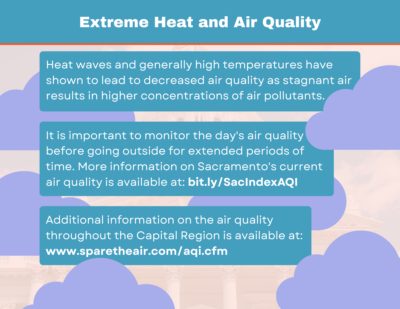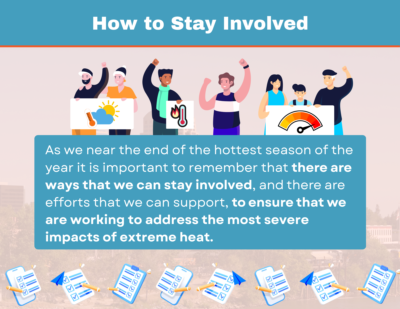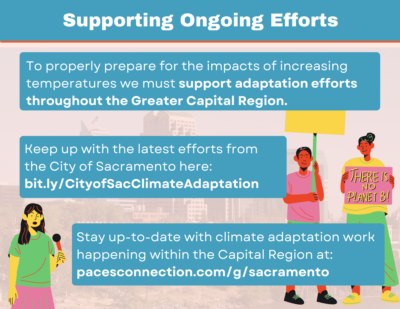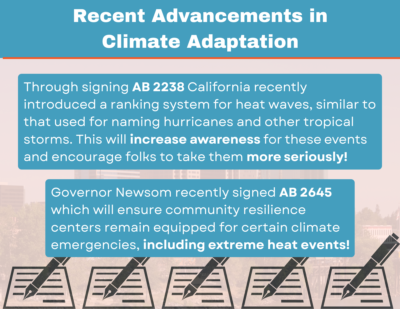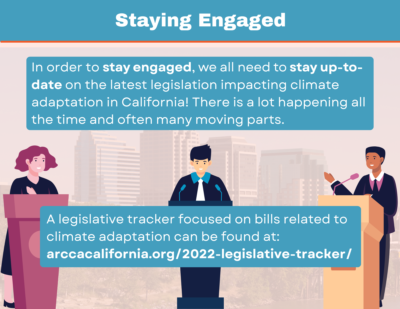Week 1 (July 5 – 8): An Introduction to the Dangers of Extreme Heat
CRCRC is launching its annual Heat PSA! Over the next 10 weeks CRCRC will be sharing resources and actionable strategies for building climate resilience throughout the Capital Region. Week 1 is focused on an introduction to the dangers of extreme heat and some basic strategies we can implement to mitigate its worst impacts.
We welcome any organization in the Capital Region to participate and help spread resources to the communities we serve on the impact of extreme heat and importance of climate resilience. We ask that you use your organization’s social media accounts to share Heat PSA content throughout the ten weeks. If you prefer to retweet or share posts from CRCRC, we will be posting the content from Twitter (@cap_climate) and Facebook (https://www.facebook.com/capclimate). If you are interested in signing up, please click the button below.
Extreme heat is dangerous and, unfortunately, it is getting worse in the Capital Region. However, there are still measures that we can all take to ensure that we remain safe and cool during this time of the year!
Extreme heat is dangerous and, unfortunately, it is getting worse throughout the Capital Region. Scientists predict that in less than 50 years, Sacramento will likely be as hot as Phoenix, with extreme temperatures becoming increasingly common. While it is becoming increasingly hard to avoid the heat, if you stay informed and take certain precautions, you can stay cool during the hottest months of the year!
Please feel free to download and share the graphics below!
Week 2 (July 11 – 15): The Impact of Extreme Heat on Your Health
Week 2 of the CRCRC Extreme Heat PSA focused on sharing resources and information on the impact that extreme heat can have on both your physical and mental health.
Extended exposure to extreme heat conditions can lead to a variety of health risks. In addition to heat stroke, extreme heat can have significant negative impacts on your mental health and exacerbate existing physical and mental health conditions.
Please feel free to download and share the graphics below!
Week 3 (July 18 – 22): Building Personal Resilience to Extreme Heat
Week 3 of the CRCRC Extreme Heat PSA focused on sharing resources and information on how individuals can best prepare themselves for the hottest days of the year.
Are you taking the correct steps to make sure you are prepared for the hottest temperatures of the year? Make sure that you are doing what you can to stay cool, and be aware of some misconceptions about extreme heat!
Please feel free to download and share the graphics below!
Week 4 (July 25 – 29): Extreme Heat and Vulnerable Communities
Week 4 of the CRCRC Extreme Heat PSA focused on sharing resources and information on how members of specific vulnerable communities can be better equipped to stay cool in extreme heat conditions.
While we are all vulnerable to the effects of extreme heat, some groups are particularly susceptible to these impacts. There are specific measures that can be taken to ensure groups such as the unhoused, the disabled, children, and the elderly are able to keep cool this summer.
Please feel free to download and share the graphics below!
Week 5 (August 1 – 5): Cooling Centers
Week 5 of the CRCRC Extreme Heat PSA focused on sharing resources and information on cooling centers. These centers can not only provide community members a place to get cool during the hot summer months, they can also be used as a space to provide essential services and resources!
Cooling centers can save lives during extreme heat days! In addition to providing a place for community members to get cool during the hottest days of the year, they can provide essential services and resources like food, water, and health services.
Cooling centers can save lives during the hottest days of the year! These community spaces often provide a place for community members to get cool during the hottest summer days. Cooling centers are often held in community spaces such as libraries, schools, or religious centers.
In addition to providing a space to get cool, these centers may also offer some life saving resources such as food, water, and health services. You never know when you might need to access a cooling center so it is important to know where they are located and when they are open.
Please feel free to download and share the graphics below!
Week 6 (August 8 – 12): Transportation
Week 6 of the CRCRC Extreme Heat PSA focused on sharing information on how high temperatures can impact our transportation infrastructure.
Extreme heat can have lasting impacts on our transportation infrastructure while creating dangerous environments for those who use public transit to commute. Here is some information on these impacts and some tips on how to stay cool while commuting.
Extreme heat can have lasting, damaging impacts on our transportation infrastructure. The hottest days of the year can lead to damage of our roadways as pavement begins to soften and expand. This can also create “rutting and potholes, particularly in high-traffic areas and can place stress on bridge joints. Heat waves can also limit construction activities, particularly in areas with high humidity.” U.S. EPA Climate Impacts on Transportation.
In addition to the direct impacts on our transportation infrastructure, high temperatures can also impact how we utilize that infrastructure. Public transit can become dangerously hot during the peak temperatures of the summer. This is why it is important to take certain precautions to ensure that how we commute is as safe as possible.
Please feel free to download and share the graphics below!
Week 7 (August 15 – 19): Housing
Week 7 of the CRCRC Extreme Heat PSA focused on sharing information on how high temperatures can impact our housing stock while also providing solutions to homeowners and renters.
Extreme heat can have lasting impacts on our housing. However, there are solutions and resources available for both homeowners and renters! Some of those resources are available here:
The impacts that high temperatures can have on our housing are numerous. However, there are solutions available for both homeowners and renters. Whether it is working to reduce energy consumption or utilizing no-cost strategies to keep our living spaces cool, there are steps we can all take to keep our homes cool during the summer! Find some of those resources below:
Please feel free to download and share the graphics below!
Week 8 (August 29 – September 2): Tree Canopy and Extreme Heat
Week 8 of the CRCRC Extreme Heat PSA focused on sharing information on the benefits of increasing urban tree canopy and some resources that can help plant more trees in our communities!
In addition to making our communities more livable, increasing our urban tree canopy can help to combat the most severe impacts of extreme heat! Information on the benefits of greater tree coverage as well as resources to plant more trees in our communities are available below:
The benefits of increasing our urban tree canopy are numerous. Not only can planting more trees in our communities beautify our neighborhoods, increase air quality, and improve urban water management, they also alleviate the most severe impacts of extreme heat!
More information on these benefits and additional resources on how to plant more trees in our communities are available in the graphics below.
Please feel free to download and share the graphics below!
Week 9 (September 5 – 9): Extreme Heat and Other Climate Impacts
Week 9 of the CRCRC Extreme Heat PSA focused on sharing information on the compounding effect of extreme heat and other climate impacts.
Extreme heat often exacerbates the severity of other climate impacts. Regardless, there are steps that we can take to ensure we stay informed and prepared for these compounding climate impacts!
Extreme heat often exacerbates the severity of other climate impacts. Regardless, there are steps that we can take to ensure we stay informed and prepared for these compounding climate impacts! Some resources on how to better prepare for seasonal wildfires, drought, and decreased air quality can be found below.
Please feel free to download and share the graphics below!
Week 10 (September 19th – 23rd): Staying Involved
Week 10 of the CRCRC Extreme Heat PSA focused on sharing opportunities to stay involved and up-to-date on the latest work being done to advance climate adaptation efforts throughout the Capital Region and the state.
Even as the hottest season of the year comes to end it is important to be aware of the ways that we can continue to stay engaged and advance climate adaptation efforts throughout the Capital Region and the state of California.
Even as the hottest season of the year comes to end it is important to be aware of the ways that we can continue to stay engaged and advance climate adaptation efforts throughout the Capital Region and the state of California. The graphics below include resources on how to stay up-to-date with the latest in climate adaptation efforts and information on the latest advancements in the field.
Please feel free to download and share the graphics below!





